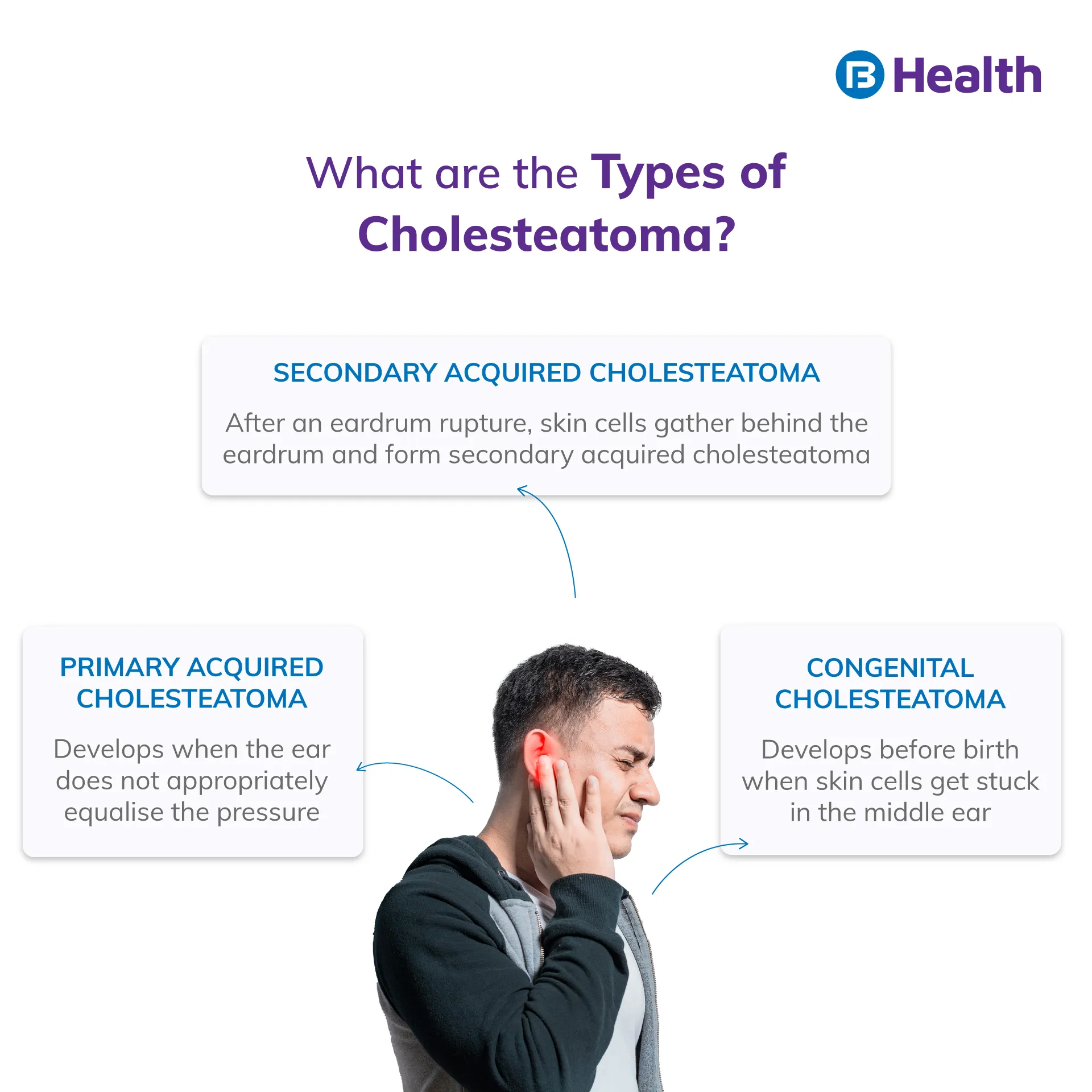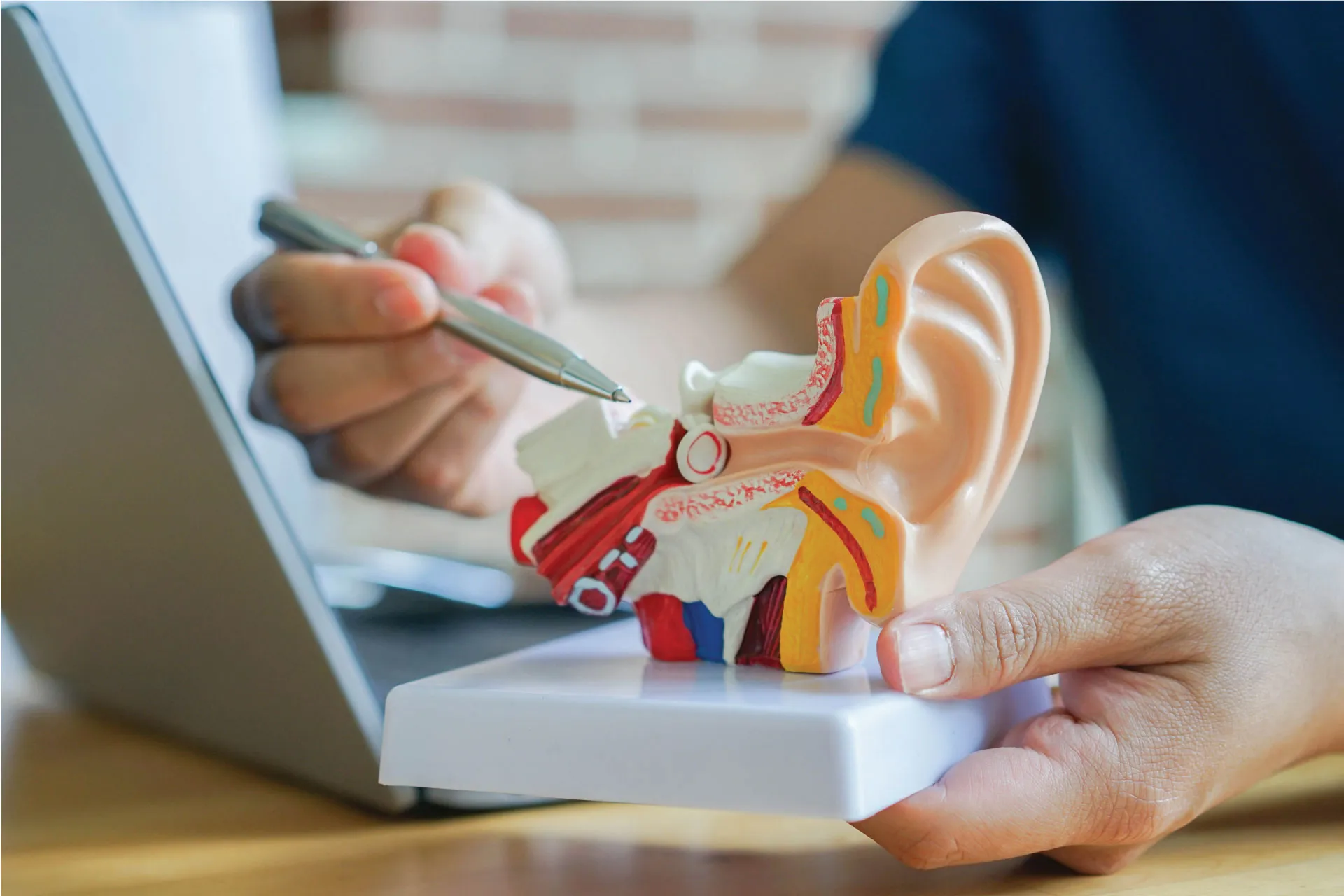Ent Surgeon | 5 min read
Cholesteatoma: Causes, Symptoms, Complications, Treatment
Medically reviewed by
Table of Content
Synopsis
An abnormal skin growth called a cholesteatoma can appear in the middle ear. Typically, it starts as a mass of dead skin cells before turning into a cyst-like pocket behind the eardrum. It can seriously affect a person's hearing, balance, and facial muscles.
Key Takeaways
- Cholesteatoma is caused due to infections of the ear that occur more repeatedly
- Symptoms of cholesteatoma include a decline in hearing, ear discomfort, and common ear infections
- Surgery could be required to treat the condition by rebuilding the eardrum, constructing new hearing bones, etc.
What is Cholesteatoma?
Cholesteatoma's meaning and definition are as follows: An abnormal, non-cancerous growth that develops beneath or from the eardrum is known as cholesteatoma. It resembles a cyst and comprises connective tissue and skin cells. A cyst or sac that exfoliates layers of old skin frequently forms a cholesteatoma. As dead skin cells build up, the growth may get bigger, breaking the middle ear's fragile bones. Cholesteatomas can enlarge in some cases, and rarely they result in severe problems, including irreversible hearing loss.
Cholesteatomas are uncommon, with an annual incidence of 9.1–12.6 per 100,000 adults and 3.0–15 per 100,000 children for acquired forms (those not present at birth). [1] Boys are more likely than girls to get this condition, and Caucasians have the greatest rate of these growths.
According to a study, males were 1.4 times more likely than women to have acquired cholesteatoma. Since cholesteatoma may occur in families, researchers believe there may be an inherent genetic connection. [2]
A cholesteatoma can lead to many issues, including hearing loss, imbalance, and even death if it is not treated. The best therapy for cholesteatoma is typically surgery to remove it.
Additional read: Suffering from Hearing Loss?Types of Cholesteatomas
Primary acquired cholesteatoma
Develops when the ear does not drain adequately or equalises the pressure (eustachian tube). Cells can gather because of poor drainage, and the pressure drags the eardrum toward the middle ear
Secondary acquired cholesteatoma
After an eardrum rupture, skin cells gather behind the eardrum and form secondary acquired cholesteatoma
Congenital cholesteatoma
Develops before birth when skin cells get stuck in the middle ear

Causes of Cholesteatoma
In addition to recurring infections, a dysfunctional eustachian tube that connects the middle ear to the back of the nose—can also be the source of cholesteatomas.
- Air may circulate through the ear and equalise the pressure through the eustachian tube. It might not function correctly because of the following reasons: Persistent ear infections
- Sinus problems
- Colds and allergies
A partial vacuum in your middle ear might occur if your eustachian tube isn't functioning properly. As a result, your eardrum may be partially dragged into your inner ear, resulting in a cyst that may form a cholesteatoma. The growth keeps getting larger as it fills with fluids, waste materials, and old skin cells.
Additional read: Tinnitus CausesSymptoms of Cholesteatoma
Cholesteatomas in the early stages may not show any symptoms. Other than hearing loss or recurring ear infections, children might not exhibit any other symptoms. However, discharge may be one of the initial symptoms in both toddlers and adults.
Discharges might be:
- Dark
- Foul-smelling
- Pus-like
- Containing earwax
- Sticky
As the cyst enlarges, it may get an infection, increasing the outflow and irritation. You could also encounter:
- Altered sense of smell and improper food flavouring
- Dizziness
- Ear pain
- Your ears may feel full or under pressure

Diagnosis of Cholesteatoma
Your doctor will use an otoscope to look into your ear to see if you have cholesteatoma. Your doctor might examine you using this medical tool to check for indications of a cyst that is expanding. They will search for a noticeable accumulation of skin cells or a significant number of blood vessels in the ear.
If there are no overt symptoms of a cholesteatoma, your doctor may need a CT scan. A CT scan may also be prescribed if you exhibit specific symptoms, such as weakness in your facial muscles and disorientation. An imaging test called a CT scan takes pictures of a cross-section of your body without discomfort. For example, your doctor can view your ears and skull's interior. By doing so, they may be able to see the cyst more clearly or rule out any other potential reasons for your symptoms.
Treatment of Cholesteatoma
Regular cleanings at a doctor's office may be sufficient therapy if a cholesteatoma is tiny and confined and the patient can handle the process.
However, surgery is required for the great majority of cholesteatoma treatments. Cholesteatomas do not spontaneously disappear; instead, they frequently recur and worsen. Therefore, surgery is often the best option to remove a cholesteatoma and avoid any consequences.
Doctors will attempt to treat any infections in the region before surgery. To minimise infectious inflammation in the tissue around the growth, they could advise antibiotic medication.
Since the operation is frequently performed as an outpatient procedure, the patient is not required to stay in the hospital overnight. However, a very big cholesteatoma or a severe infection may necessitate hospitalisation.
Cholesteatoma surgery helps restore the ear to a healthy, stable, and reliably functioning state by removing the tumour and treating other infections. The cholesteatoma's location and the treatment's extent will determine the surgeries the surgeon must undertake. You will need follow-up appointments after the cholesteatoma is removed to assess the findings and ensure the cyst hasn't returned. You would require further surgery to fix broken ear bones caused due to the cyst.
Some patients report passing vertigo or strange tastes after surgery. Almost typically, these adverse effects go away on their own within a few days.
Complications of Cholesteatoma
- A cholesteatoma will enlarge and develop consequences that might be minor to severe if left untreated
- The build-up of dead skin cells in the ear creates the perfect conditions for bacteria and fungus to flourish. This indicates that the cyst may contract an infection, resulting in inflammation and persistent ear draining. If the cyst doesn't get better, it can weaken your appearance by growing into your face
- A cholesteatoma may eventually obliterate the nearby bone. It can harm the nerves in the face, the eardrum, bones within the ear, bones close to the brain, and the ear bones. If the bones inside the ear are damaged, it might result in permanent hearing loss
- Other issues that might arise are chronic ear infections, swollen inner ear, facial muscle paralysis, meningitis, a potentially fatal brain infection, brain abscesses, or pus-filled spaces in the brain
Bajaj Finserv Health provides personalised healthcare services for you and your family. You can choose the best physicians in your area, set up reminders to take your medications, save all your medical information in one location, and even get online doctor consultations.
References
- https://www.ncbi.nlm.nih.gov/pmc/articles/PMC4381684/
- https://www.ncbi.nlm.nih.gov/pmc/articles/PMC6081285/
Disclaimer
Please note that this article is solely meant for informational purposes and Bajaj Finserv Health Limited (“BFHL”) does not shoulder any responsibility of the views/advice/information expressed/given by the writer/reviewer/originator. This article should not be considered as a substitute for any medical advice, diagnosis or treatment. Always consult with your trusted physician/qualified healthcare professional to evaluate your medical condition. The above article has been reviewed by a qualified doctor and BFHL is not responsible for any damages for any information or services provided by any third party.





